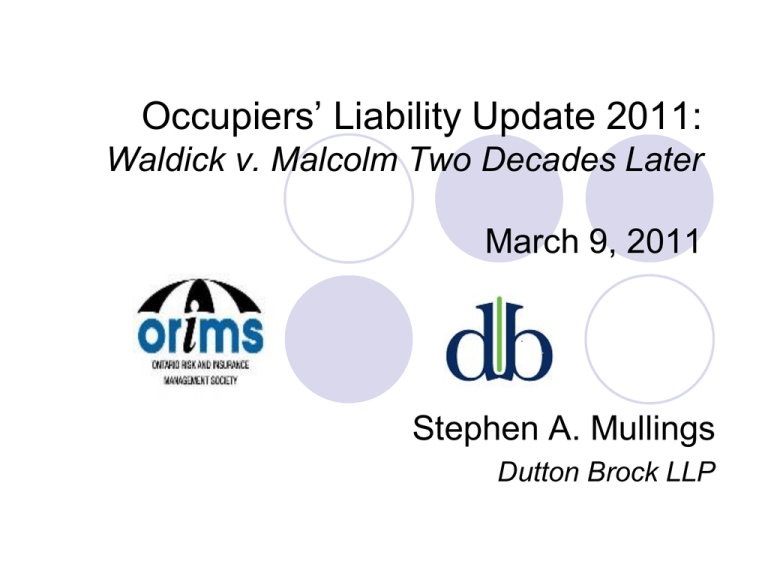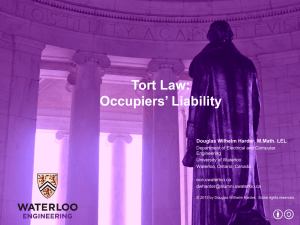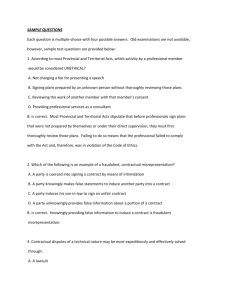Occupiers Liability (Stephen Mullings)
advertisement

Occupiers’ Liability Update 2011: Waldick v. Malcolm Two Decades Later March 9, 2011 Stephen A. Mullings Dutton Brock LLP Occupiers’ Liability Start with reading/re-reading the Occupiers’ Liability Act Act codifies common law definition of occupier and duties Waldick v. Malcolm remains leading occupiers’ liability case Each case will be decided on its own facts Section 4 defence of voluntary assumption of risk rarely invoked Consider trial with a jury in cases that you are able 2 Section 1 of Occupiers’ Liability Act 1. In this Act, “occupier” includes, (a) a person who is in physical possession of premises, or (b) a person who has responsibility for and control over the condition of premises or the activities there carried on, or control over persons allowed to enter the premises 3 Section 3 of Occupiers’ Liability Act Occupier’s duty 3.(1) An occupier of premises owes a duty to take such care as in all the circumstances of the case is reasonable to see that persons entering on the premises, and the property brought on the premises by those persons are reasonably safe while on the premises. 4 Section 4 of Occupiers’ Liability Act Risks willingly assumed 4.(1) The duty of care provided for in subsection 3(1) does not apply in respect of risks willingly assumed by the person who enters on the premises, but in that case the occupier owes a duty to the person not to create a danger with deliberate intent of doing harm or damage to the person or his or her property and to not act with reckless disregard of the presence of the person or his or her property. 5 Waldick v. Malcolm 6 Waldick v. Malcolm – 1991 (S.C.C.) First case involving Occupiers’ Liability Act that went to Supreme Court of Canada in 1991 Issues 1. Relevance of local customs 2. Occupiers’ duty under the circumstances 3. S.4 and Voluntary assumption of risk (a) knowledge of physical risk; and (b) consenting to legal risk. 4. Contributory negligence 7 Galka v. Stankiewicz – 2010 (Ont. S.C.J.) 8 Galka v. Stankiewicz – 2010 (Ont. S.C.J.) Co-defendant City of Toronto operated archery range Co-defendant archer had no training and was inexperienced Plaintiff agreed to ill-conceived plan to retrieve lost arrows City knew users regularly violated rules by retrieving arrows adjacent to other targets – this did not amount to liability – accident was unpredictable and therefore, not foreseeable Section 4: Voluntary assumption of risk (volenti) The plaintiff’s agreement was not enough to invoke s.4 of the Act Contributory negligence Plaintiff and co-defendant made choices – both found 50% liable 9 Schneider v. St. Clair Region C.A. – 2009 (Ont. C.A.) Plaintiff was skiing off-trail when she struck a concrete wall At trial, municipality was held to be 80% liable (plaintiff 20%) Trial judge said s.4 – voluntary assumption of risk did not apply Court of Appeal overturned trial decision and s.4 applied Defendant not liable Interpretation of “reckless disregard” Key: defendant lacked knowledge Rare decision applying s.4 Distinguished from Onyschuk, Herbert 10 Herbert v. Brantford – 2010 (Ont. S.C.J.) Injured while using property for recreational purposes (off-trail) City in this case had an inspection system Path had little or no recovery zone and loose rocks and boulders Loose rocks on pathway not properly reported after inspections Judge held that inspection system failures = reckless disregard Reckless disregard was substantially connected to injuries Distinguished from Schneider on issue of reckless disregard Plaintiff held to be 60% liable; City was 40% liable 11 Musselman v. 875667 – 2010 (Ont. S.C.J.) Tragic case - plaintiff rendered paraplegic after fall down stairs No guards, no wall and no rail on the west side of staircase Landlord, tenant restaurant owner and City of Toronto sued Lease was a “completely care-free net lease” Landlord found not to be an occupier pursuant to s.1 of Act Tenant was occupier and breached duty of care in s.3 of Act Restaurant stairs were grossly noncompliant with Building Code, the City’s own building and property standards by-laws City was negligent in approving plans for staircase – it should have been apparent that it was unsafe – “accident waiting to happen” Tenant was 70% liable and City was 30% liable 12 Ouderkirk v. Clarry – 2010 (Ont. C.A.) - Plaintiff fell from new deck – broke ankle - Deck had no railings, temporary stairs - Did not comply with Building Code - Building permit never obtained - Defendant testified that plaintiff warned - Plaintiff said she did not see temporary stairs - Jury held no breach by occupier and that the plaintiff failed to take reasonable care for her own safety - Jury verdict upheld by Ont. C.A. – difficult to overturn jury verdicts - Distinct from Musselman – both non-compliant with Building Code 13 Taylor v. Allard – 2010 (Ont. C.A.) Tenants hosted party which of course involved drinking Plaintiff attended drunk and fell while trying to avoid fight Fell on cinder block ringing the fire pit Landlord had installed cinder blocks At trial, judge held that tenants and plaintiff were each 50% liable Ont. C.A. varied the judgment and held that the landlord was to share in 50% of the liability with the two tenants (1/3 of 50% each) Landlord was occupier (admitted in pleadings) and breached duties under sections 3 and 8 (s.8 – failure to repair and maintain premises); in particular danger created by installation of blocks Distinct from Musselman on landlord issue 14 Conclusion 1. Read and re-read the Occupiers’ Liability Act – codified common law 2. Waldick continues to be the leading case 20 years later 3. Each case to be decided on its own merits 4. S. 4 defence of Volenti / voluntary assumption of risk is rarely applied 5. Juries – defendants like them because of their common sense 15 Questions? 16 Thank you!






